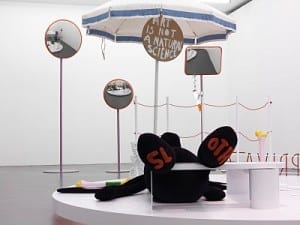German artist Sybille Neumeyer stunned judges with her eloquent piece, Song for the Last Queen (2013) in the Aesthetica Art Prize, a beautiful light installation comprised of 7,614 bees collected from a naturally collapsed beehive framed within vials of natural honey. Captivating at first glance, the work also invites audiences to reflect upon global issues and imbalances in our ecosystem; at once appreciating the pure and natural beauty of raw materials while confronting the growing gap between consumption and food production, as bees face an ever-rising risk of decline. We speak to Neumeyer about her practice and what inspired her to enter the Aesthetica Art Prize.
A: Although based in Germany, you have travelled a lot to produce your work, working with bee keepers throughout America and Europe. How do you feel about taking part in the Aesthetica Art Prize and bringing Song for the Last Queen to the UK?
SN: The Aesthetica Art Prize is my first exhibition in England and I am very pleased to see my installation in the wonderful venue of St Mary´s and feel honoured to be chosen from so many entries. To show the installation in York for a period of three month is a valuable chance to reach a broad audience, especially as the intention of the work is to create visibility for a relevant ecological topic.
I am glad I could take part in the opening event to meet artists and local art professionals and to exchange ideas about our practice, as well to see the art works from the longlisted and shortlisted artists. From the numerous visitors who came to the exhibition opening, I still remember some very interesting discussions about the endangerment of bees and appreciate the feedback and input I received.
As unfortunately my stay in England was too short to give an artist’s talk offering further insight into my work, I am glad the events running alongside the exhibition included a workshop for children related to Song for the Last Queen, and encouraged a young generation to reflect upon their environment.
A: The group exhibition showcases the work of a further seven artists, spanning media from film to painting and photography to sculpture, and covering a wide range of topics from playing with form to reflecting on social minorities. Were there any pieces that particularly resonated with you, based on either form or content?
SN: The exhibition shows outstanding works from different disciplines, so it is difficult to compare or give a preference for one. Though, I particularly like two works: Longplayer by Ingrid Hu and Frustum Super Planum Cum Filia Lyrae by Harriet Lewars. Both enable a visual and an acoustic experience, and explore the temporal borders of sound as well the intersection of sculptural and instrumental qualities, which I think is a very interesting interdisciplinary, and therefore contemporary, artistic approach. I enjoyed exploring them from different perspectives and listening to the peculiar sounds.
A: What motivated you to create Song for the Last Queen?
SN: According to my interest in biology, botanics and other natural sciences my projects often start in field observation where I connect ecological questions with a closer observation of plants, animals and natural phenomena. Researching about bees and working with beekeepers since 2012 I got deeply fascinated by this species and their significance for our ecosystem, by the intelligence and behaviour of a swarm and by the simple but purely beautiful materials in the hive.
In conversations with bee keepers, scientists and locals about the endangerment of bees I realised that the knowledge and awareness of the topic, as well as the emotional involvement, vary from one person to another, and from country to country – even though the signs for increasing ecological imbalances are the same worldwide.
Creating this installation I aimed to bring a new visibility to the subject. Using honey and the bees as a raw material I involve questions about preservation, ecological responsibility and the growing gap between consumption and food production. Dealing with global issues contemporary art is not only able to raise awareness and urge ecological problems, but also to create an emotional impact which is different from feeling confronted with abstract numbers and data we receive through the media.
In response to Song for the Last Queen I hope for an involving experience for the audience, so the perception of the piece in its entirety and its individual parts depends on distance and perspective, gradually shifting when you approach it. Attraction and silence embrace the viewer while a rather cryptic message appears in the pattern of black spots on the golden-yellow background. Somewhere between this order and disorder, control and chaos, presence and absence, the fields of knowing and searching are blurred.
A: How did you collect the bees and honey?
SN: After the very harsh winters in 2012 and 2013 a beekeeper called to inform me that one of his hives did not survive. I took the entire beehive to my studio and examined it carefully. It seemed the colony had already consumed most of the honey and the remaining combs were filled with their larvae. Most of the dead bees had dropped to the bottom of the hive but many were still sitting on the frames and in the comb, like they were frozen in the midst of motion.
I took them out, one after the other, cleaned them and placed them in order. I had around 17,000 bees, from which I used almost 8,000 for Song for the Last Queen. During summer a colony can have up to 60,000 – 80,000 bees in one hive. So the amount of 7,614, which is the exact number of bees in Song for the Last Queen, is just around one eighth of an entire colony. The triptych, which resembles three pages of a musical score, is in a poetic way tackling the question of how we perceive such abstract numbers when facing them one-to-one in a material representation.
After experimenting with different types of honey I chose the type which had the right colour and consistency to suit my purpose. I compared organic honey with cheap supermarket honey, wild flower honey with acacia honey, forest honey and many more. Unfortunately, the amount left in the hive itself was too little to work with, so I bought the additional honey. Being aware of the organic texture of the substance I used pure honey – including its ephemeral characteristics in my artistic reflection rather than trying to intervene in the material with any preparation substances.
A: What was your experience of using organic materials for an artwork?
SN: Related to my focus on a relation between human and nature I regard nature rather as subject than material. On the search for the narratives and significances beyond the pure materials, the analysis and dissection of the honey and bees was a starting point for deeper understanding and artistic reflection. I pondered about the role of the individual in a system as I handled each bee one by one and with care during the preparation – noticing their different sizes, gender and appearance.
Indeed, organic materials can be challenging, too. You can chose them but cannot edit or control them unless you interfere in their substance. Nevertheless organic materials naturally provide unexpected potential. Dealing with honey, I soon became aware of its conserving yet ephemeral qualities. This contrast has an important impact on the creation of the artwork as the tension between preservation and decay is not only a material aspect but a, ecological and philosophical question as well.
A: In travelling around the world to complete your project working with beekeepers, did you find there were differences between the ways in which cultures perceive our responsibility to the environment?
SN: Responsibility to the environment is an urging global issue, but still there are gaps between its perception and execution in different countries. A nation´s attitude towards nature and environmental issues evolves from geological and climatic circumstances, from traditions of nutrition and agriculture, transformed by the impact of mass production, food policies and consumerism.
Still, economic growth and development shape most human activities, even their ability to cause damage and affect the environment is so evident. Hence a visibility, transparency and understanding of the connection between ecological problems and human activity became in the last years the essential objective of contemporary art, science and philosophy.
During my travels I approach an understanding of the local conditions and then critically reflect and interpret their interrelations on a transnational level. My impressions and experiences help me to build a trans-local knowledge. Seeing the different extremes and understanding controversial attitudes allows me to investigate diverse perspectives, and to position my work within in a global discourse.
A: Since embarking on this travelling project, what have you discovered about the crossover between science and art?
SN: Practices of art and science have been intersecting and influencing each other since many centuries. Since the 20th century, the discourse on the interplay between art and science has been resumed with growing attention. Projects of artistic research, design research and collaborations between scientists and artists are now defining contemporary culture in Germany and elsewhere.
I am personally interested in the disciplinary overlap and in methodologies, in similarities and differences in the process of art and science, too. By switching between artistic and scientific methods I allow myself to be at times a “silent observer” of the process and material before I then intervene again. I regard science and art both as different approaches for raising questions and finding answers. Nowadays scientists and artists share more and more the same questions, working processes reveal similarities. In the exchange of their knowledge and questions is a deep value and the opportunity for a closer dialogue and a mutual critical reflection.
A: What do you intend to do now since winning the Main Prize for the Aesthetica Art Prize?
SN: The award helps me to progress with my projects by giving me financial support as well as the possibility to engage with new audiences. During the next few months I am researching and working on new projects in Romania and Finland for my next exhibitions. Also, I am developing the large scale installation of Song for the Last Queen, including a whole colony. Hopefully, my work brings me to England again soon.
To see more of Sybille Neumeyer’s work visit www.sybilleneumeyer.com.
The Aesthetica Art Prize is open for entries. Submissions close 31 August. For more information and to submit visit www.aestheticamagazine.comartprize.
credits
1. Sybille Neumeyer, Song for the Last Queen. Winner of the Aesthetica Art Prize 2014.
2. Sybille Neumeyer, production short. Courtesy of the artist.





